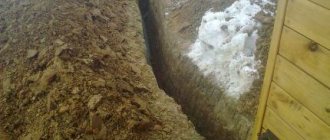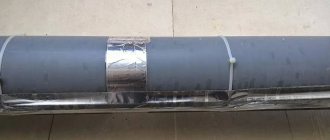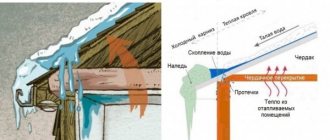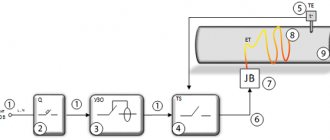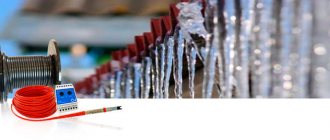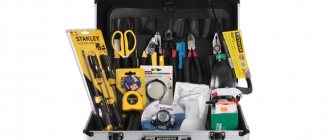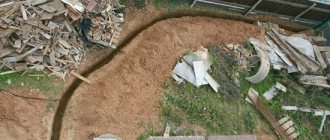Winter cold poses a great danger to water supply systems, especially when it comes to private homes located outside cities and large settlements. Due to poor thermal insulation, pipes may freeze, which will result in a cutoff in water supply. The deeper the pipes are laid, the less susceptible they are to the harmful effects of cold weather. To avoid such situations, it is important to consider a high-quality protection system. The best option is a self-regulating heating cable, which is guaranteed to save pipes from ice jams.
What is a self-regulating wire
Structurally, a self-regulating cable is a flexible wire through which electrical energy flows. This is what causes it to heat up. To prevent the process of increasing temperatures from leading to fire or failure of the cable and nearby objects, the product is able to independently regulate its power depending on the ambient temperature. A simple relationship is observed: the lower the mercury column, the hotter the cable. The surprising thing is that the heating process can occur exclusively in a specific area where it is needed. If any part of the cable is at room temperature, then the power will be lower, and accordingly, the product will not heat up.
If we consider the design of the heating wire globally, we can distinguish three main components:
- conductors made of various metals through which electrical energy flows;
- a “smart” matrix of polymer substances that forces the cable to adapt to the ambient temperature and regulates the process of heat generation;
- an insulating shell consisting of many layers.
The main element that explains the principle of operation of the heating cable is the polymer matrix. Thanks to its presence, the wire exhibits self-regulating properties. The matrix consists of small particles, so its individual elements regulate heating independently of each other. This way, you don’t have to connect various sensors and other electronics to properly regulate the temperature.
Another useful cable option is that you can choose the length you need. Take regular scissors and cut the product where you need it. Connect to the network, as a result it will work without changes. Similar to self-regulation at every centimeter, the cable elements function and work independently of each other. An accidental break will not lead to failure. But such situations are rare, since the cable design is characterized by increased strength.
The main useful properties of a heating cable include:
- Increased resistance to mechanical stress. This is due to the presence of high-quality multilayer insulation.
- Resistant to moisture. It can be used in the water column without any problems. The main condition for this is to perform high-quality insulation using heat-shrinkable tubes.
- Economical. Since the cable independently regulates power, the product never works “just like that.”
The high strength is due to the multilayer structure, with the first two layers consisting of copper conductors and a polymer matrix. Already on top of them is installed insulation made of different materials (for example, fluoropolymers or polyolefin).
After this comes a layer of armor, which is used as copper braiding. Finally, an additional polyolefin layer is placed on top of it all. This design significantly increases the endurance and strength of the product. The copper braid also functions as a shield against electromagnetic radiation.
Application in the national economy
- In construction work, self-regulating cables are used to protect communication systems from icing. In this case, the electrical connection can be located in the inside of the pipeline and on the outside. This circumstance is important when the pipeline from a well or sewage disposal system is laid on the soil surface, and it needs to be protected from icing in the cold season. The situation is similar with foundations located at shallow depths. In this case, the pipeline running from the pumping station to the comb, where the control units are located, also requires additional protection from the cold. Here you should take into account the possibility of cutting off part of the connection of the required length, which will greatly help optimize the electricity consumption required for this system.
To increase the temperature in the internal part of the fresh drinking water supply, compounds are used, the hygienic safety of which is confirmed by a special document. Such cables are installed using special glands and interact with drinking liquid. These are profile connections approved by environmental control organizations;
- To protect against the formation of ice on stairwells, landings, parking lots, and devices for lifting wheelchairs in order to prevent people from receiving various injuries, appropriate temperature increasing systems are also used;
- To protect the roof and its elements from cold , to prevent icing of water removal systems from the roof. Installing a cable can prevent the formation of ice crusts and icicles. If these steps are not taken, damage may occur to the roof, water removal pipes, and cable networks. Falling ice formations from the roof can cause damage to both property and the life or health of people;
- In the gas, chemical and oil industries to increase the temperature inside pipes in a cold atmosphere (in order to prevent them from icing); to increase the temperature of pipes to increase the permeability of substances flowing through them (in order to prevent the appearance of very dense formations and narrowings that interfere with permeability);
- To regulate the temperature of tanks with oil industry products (oil, bitumen, tar, etc.). The same is true for chemically active solutions, substances, etc. Security measures make it possible to prevent property damage;
- In the food industry , they increase the temperature of the drainage pipes of refrigeration units, generate evaporation in refrigeration units, warm drainage trays from the compartments of refrigeration units, and increase the temperature of the crankcases of piston types of pumps before activating them in cold conditions. In addition, self-regulating cables increase the temperature of individual food, fresh water and fire-fighting tanks;
- To increase the temperature of the earth's surface in various agricultural buildings, including greenhouses and premises for keeping livestock. Due to systems based on electrical connections capable of automatic regulation, it becomes possible, at low cost, to create comfortable conditions in such buildings throughout all seasons of the calendar year, which has a good impact on the agricultural industry as a whole.
Operating principle and scope
The main difference between a self-regulating wire and cables of resistive and zonal operating principles is the design.
The resistive product operates on the principle of a boiler, so it is prohibited to shorten it. In this case, the conductors are the heating elements.
The zone heating wire can be cut into pieces, since its design involves the placement of parallel wires. A heating element consisting of high-resistance wire is placed between the cores. In certain areas, the wire comes into contact with the current-carrying conductor, which ensures heating in a specific section of the circuit.
As for the self-regulating cable, it differs from the previous two in the presence of a polymer matrix. The main elements are hidden under the braiding and protective screens - two current-carrying copper cores and a heating matrix. When examining the latter, you will find ordinary polyethylene. In fact, this device made it possible to create unique and modern heating elements. The matrix is a semiconductor that changes properties depending on the specific air temperature.
Example with heated floors
Self-regulating cables can be used to create heated floors. In the bathroom, the floor temperature will be lower, since heating equipment is usually installed in other rooms. The “degree” is also reduced by the fact that the floor in the bathroom or toilet is usually made of ceramic tiles, which are a “cold” building material. The temperature difference is not limited to this: at one end of the room it can be higher, at the other, which is closer to the windows, lower.
In this case, when using resistive or zone conductors, you will not be able to achieve a comfortable balance. The only way to do this is to divide the rooms into parts depending on the floor temperature under normal conditions, but this is a labor-intensive and painstaking process that involves installing thermostats and heat sensors.
The self-regulating wire eliminates the need to use such elements. You can place it over the entire surface of the floor, while the polymer matrix will take care of itself to create a uniformly heated floor surface. A simple but understandable example: you came home from the street and left your shoes, soaking wet, on a specific area of the floor. The self-regulating cable will detect a cold snap and begin to heat this area more strongly than others. This will happen until your boots warm up to the required temperature. And you will go outside in warm shoes! If there are no boots, then the cable does not heat up as much, which means energy savings occur.
Plumbing example
To prevent water from freezing in extreme cold, a self-regulating cable is used to wind the water valve. The valve is a structure of complex geometric shape, due to which the product cannot be in direct contact with every part of the metal. Zone and resistive wires will heat not only the valve, but also the environment.
If you install a self-regulating cable, the heating process will occur only in places of contact with metal. The principle of operation of the product is based on the efficiency of heat transfer: the more pronounced it is, the more the wire heats up. It is clear that upon contact with cooled metal, the thermal output will be much higher. This leads to an increase in the efficiency of the self-regulating wire compared to other heating analogues.
Example with roof heating
The roof is susceptible to icing in random areas, so it is impossible to determine a specific one. Thus, when using a zonal or resistive heating cable, you will have to lay it over the entire surface of the roof. This will significantly increase energy consumption.
Use a self-regulating cable with a semiconductor matrix, due to which only the area of the roof that freezes and where icicles can form will be heated. Moreover, after it is heated, the cable operates at half power for some time, so the efficiency of its operation is much higher.
History of the invention of self-regulating cable
It is believed that the prototype of the self-regulating cable appeared in Norway during the Second World War. On September 16, 1940 (i.e., even before the outbreak of hostilities in this country), a patent was published in Oslo under number 747,883, the author of which was Peder Gunnar Sletner. However, due to the war and occupation, this patent was not considered. Its author was forced to emigrate to the United States, and only on May 14, 1947, he resubmitted his text to the US Patent and Trademark Office. The documents were carefully studied by the commission for more than two years. As a result, on January 17, 1950, this patent was officially published by the Office under the unique number US2494589 A.
According to the published text, an invention was patented representing a structure of two or more electrical conductors with opposite polarity (phase and neutral). Electricity conductors run parallel to each other without intersecting, but at the same time, they are connected to each other thanks to the nth number of contacts (resistors) parallel connected to them. Resistors are thin wire spirals made of high resistance metal. It should be noted that in the text of the patent there is currently no mention at all of the components (materials) of modern self-regulating systems - the polymer matrix. At that time, chemistry was not capable of synthesizing such complex materials. Instead, Peder Sletner offers us essentially the same resistive cable, with one unique property: it could be cut to any length without worrying about changes in its characteristics after cutting. Thus the zone cable was invented.
The Sletner cable has a significant advantage over resistive cables - if one resistor (connector of conductive cores) burns out, the system continues to operate in full mode. Only a small area of it stops heating. This invention showed great promise for using such a cable in electrical heating systems.
After Sletner's patent, a series of patents began to improve his invention. In particular, patents 3757086 and 4037083 proposed various options for resistor alloys (nichrome, fechral) to increase the power output and efficiency of the heating cable. But this did not solve the issue of self-regulation of the system.
The technology of parallel connection of heating cables, which allows cutting and coupling heating cables of any length, began to be used for commercial purposes since 1971. This technology was purchased and used for commercial purposes by the American company Raichem, currently the world leader in the production of heating cables.
Further, over the course of almost 20 years, a whole series of patents followed, mostly from American authors, who began to propose solutions that allowed the zonal cable to emit temperatures that differed in different sections of the same section.
For the first time, the solution to the issue of autonomous cable temperature control was announced in patent US4250400 A dated February 10, 1981. It proposed connecting a small tablet-shaped thermostat in the middle of spiral resistors (high-resistance wires). This disk temperature sensor protruded beyond the cable and had to be in contact with the heated surface. As the surface temperature increased, the resistance of the temperature sensor increased, which reduced the linearly flowing electric current. As a result, the cable power dropped. Thus, the first self-regulating cable in history appeared. The diagram below shows a schematic diagram of this invention.
And only, 10 years later, on June 16, 1992. patent US5122641 authored by Robert M. DeChurch appears, in which the polymer matrix is clearly beginning to be discussed as a cable heating element. The patent does not say anything about the composition of the polymer, only that it could be “various materials”, such as graphite or coal shavings. But the patented invention already contains indicative drawings of the technological process for producing the polymer matrix.
In the early 90s, the first full-fledged self-regulating cable with a polymer matrix began to appear on the market. First, these are cables manufactured by Raichem (USA), then Heat Trace (England), BARTEC (Germany), etc.
In the CIS countries, the cables from the above-mentioned manufacturers arrived in the late 90s and, due to their high cost, were initially used only in heating systems for gas and oil pipelines. Then, in the 2000s, a more affordable self-regulating cable appeared from South Korea, where some factories bought the secret of the matrix production technology. Around the same time, individual European and American manufacturers began to produce products under their own brand in factories in China. However, in the future, these factories were allowed to produce their own unbranded cable with the lack of quality control of Western manufacturers. As a result, prices for this product have decreased significantly, and now the average price of Samreg for anti-icing is $5-7 per 1 linear meter. However, there are Chinese samples for $3-4. Naturally, this does not apply to high-temperature specialized cables for industrial purposes, where the price for 1 linear meter reaches $50 or more.
Currently, some Russian manufacturers claim to have the technology for producing a self-regulating matrix. However, the quality of such a matrix is still very crude, the inrush currents are high, and the service life is very limited. Therefore, their main line of expensive cables for industrial electrical heating is produced on the basis of a matrix purchased from European or American factories.
Main types of heating cables
There are two main types of heating cable - resistive and self-regulating. Each of them will be discussed below.
Resistive wire
The principle of operation of a resistive cable differs from a self-regulating one. The inner and outer surfaces of the pipeline are wrapped with cable, after which temperature sensors are installed. A thermostat is connected to the circuit, which receives readings from sensors. It is triggered by the slightest temperature fluctuations, however, the action threshold can be set manually. If the air temperature drops, the thermostat is activated, starting the heating of the resistive cable. Electricity begins to flow through the cable, which leads to the release of heat and heat exchange with the water supply. As soon as the pipes are heated to the required temperature, the cable automatically turns off.
Structurally, a resistive cable consists of insulated metal cores. Heating occurs along the entire length of the product, but without temperature control (thermostat), the device can burn out. To increase heating efficiency, water pipes are additionally insulated in order to reduce heat losses and achieve energy costs. Any materials that do not conduct heat can serve as insulation. For example, mineral wool.
Self-regulating wire
The self-regulating cable was developed as an alternative to the resistive version. It has the best technical characteristics and properties. The product can be used for heating water pipes, roofing or forming “warm floor” systems. Structurally, the device consists of two copper conductors located separately from each other, with polymer insulation that can respond to any temperature fluctuations and change resistance. This value increases or decreases in proportion to the ambient temperature, which leads to an increase or decrease in current strength.
The polymer matrix is able to respond to temperature changes at each individual point of the cable. Thus, the temperature will be different in each area. The product is characterized by efficiency and safety due to high-quality and durable insulation. The service life can exceed 20-30 years.
Recommendation. The self-regulating cable can be cut into pieces of arbitrary length and connected separately from each other. This does not in any way affect the performance and efficiency of the product as a whole.
Types - device, technical characteristics
Heating cables are divided into the following types: resistive, self-regulating, inductive.
They differ in operating principle, technical characteristics and design.
Resistive
Resistive cables come in linear and zonal types. For its effective operation, special equipment is required that will control the conductor, focusing on the ambient temperature.
The advantage of this type is low cost, reliability, ease of installation.
It should be said that such a conductor always releases the same amount of heat, regardless of the temperature of the air masses, so the consumption of electrical energy is low - which is not economically profitable.
Resistive is divided into:
- Linear - a wire whose ends are connected to the electrical supply. According to the number of current-carrying wires - single-core and double-core.
Single-core - consists of one heating core, usually a steel core, it is covered with an insulating layer of heat-resistant material that does not deform when heated. The wire comes with a screen to remove interference that is created by the cable itself and all kinds of protective devices.
The advantage of the single-core model is ease of use. The disadvantage is that it is not possible to cut to the desired size, the need to connect both ends in one place.
Twin-core - consists of two parallel conductors that transmit electric current. Their difference and advantage from the single-core type is that the second end does not need to be returned to the connection point, this is especially convenient when heating long pipelines.
- Zonal - its design is more complex compared to linear. It consists of two current-carrying copper wires, each of which has separate insulation. In addition, it is thicker than linear.
The difference between this type is that the internal insulation is equipped with windows every 1 - 2 meters. Through them, the conductor is connected to the heating wire, taking over the network voltage.
Thanks to this design feature, constant resistance is not present in the entire conductor, but only in one or another section-zone. The advantage is the ability to select the length of the section according to your needs. The downside is the high price.
The resistive heating conductor has a warranty period of up to 15 years, and when poured into a concrete screed, up to 50 years.
Self-regulating
A self-regulating heating cable is a modern model that differs from a resistive one not only in its design features, but also in its operating principle.
Self-regulating wires are conductors enclosed in a polymer matrix. A regulator is not required for operation; it will itself maintain the temperature at which it is set, so it will not overheat. This type is more expensive, but despite this, the increased efficiency makes it more economical.
In addition, it can be cut into pieces of any size. The guaranteed service life of this type is 10 - 15 years, but manufacturers include a reserve of up to 40%, which will significantly extend its operating time.
The self-regulating conductor can be shielded or unshielded:
- Shielded - the outer shell covers a braid of tinned copper wire, which protects against mechanical damage and serves as grounding. This cable is intended not only for heating the water supply, but also for installation outdoors - roofing, drainage.
The casing can be food grade - used for heating water supply and sewer systems inside, and with UV protection - mounted on the roof, where there is a lot of sunlight.
- Unshielded - the product does not have a protective shell. It is used for heating household pipelines; it is not installed outdoors, where exposure to aggressive environments is possible.
- Outer polyolefin sheath.
- Tinned copper wire braid.
- Elastomeric thermoplastic insulation.
- Polyester shell.
- Semiconductive self-regulating matrix.
- Copper conductors.
- Outer polyolefin sheath.
- Inner polyester shell.
- Semiconductive self-regulating matrix.
- Copper conductors
Shielded models are more expensive than those that do not have a shell.
The main areas of application of self-regulating heating cable:
- household pipes;
- icing systems (roofs, walkways);
- industry.
To heat various communications, a heating element of the following power is required. For:
- pipes inside - 10 W/m linear;
- pipeline outside - 15 W/m. P.;
- roofs and paths - 24-30 W/m.p.;
- anti-icing systems - up to 40.
What power is required for a heating cable for a water supply system?
The choice of specific power of the product depends on many factors, including the region of residence, the principle of laying the water supply system, the diameter of the pipes used, the presence or absence of insulation and the method of installing the heating element (inside or outside the pipe). Each manufacturer offers detailed product characteristics and tables that describe the dependence of cable consumption per meter of pipe. The table is generated separately for a specific wire model (power).
If there is average insulation of the water supply using 30 mm polystyrene foam shell, in a temperate climate, it is enough to use a cable with a power of 10 W/m to heat each meter of pipe from the inside. For external heating, products with a power of at least 17 W/m are suitable. The closer to the north, the higher the power of the wire.
Principle of operation
A self-regulating heating cable works in the same way as a resistive conductor. It heats up, and therefore the resistance reading increases. The larger it is, the lower the current strength and power consumed. The polymer matrix works like this: as the temperature in the matrix area decreases, the current strength increases. As a result, the heating element heats up more. The temperature is regulated without the use of thermoregulatory devices. This is how thermoregulation occurs.
All wiring with a regular cable works like this: the matrix receives a current that heats the device.
Note! As a result of heating, resistance increases and current decreases. The heating cable removes heat from the walls of the wire and thanks to this action, the current flows as needed. The power of electrical equipment is increasing.
Principle of cable operation
Laying and connection
Installation of the heating cable can be carried out in two ways - external and internal. In the first case, installation takes place along the pipe (the product can be attached with electrical tape or wrapped around the water supply), in the second, it is laid inside.
Hidden installation inside the pipe
Internal installation is not suitable for all pipes. It is important that the diameter of the water supply is at least 40 mm. With a smaller value, due to its dimensions, the cable will interfere with the free flow of water. It is also difficult to place heating on an overly long route. Therefore, a self-regulating cable is suitable for sections several meters long.
It is much easier to install on vertical sections of pipes, moving from top to bottom. To perform the procedure, use a tee and a sealing sleeve, which prevents the wire from slipping. In some situations, indoor installation is more rational than outdoor installation.
Placing the wire inside and connecting it to an AC source is not difficult. Much more difficult to assemble. Use the instructions with the sequence of actions described below:
- Remove insulation.
- Unravel the braid.
- Remove the corner.
- Prepare the sealing sleeve.
- Frame the coupling using a hair dryer.
- Glue the ends of the coupling together.
- Put on the cap.
- Strip the sealed end.
Open outdoor installation
To perform linear installation of a self-regulating cable along a pipe, less effort will be required. The wire can be fixed to the pipe using plastic clamps that can withstand high temperatures or fiberglass self-adhesive tape. Fastening elements must be installed at a distance of at least 30 cm. The use of metal parts is prohibited. To calculate the length of the wire, you don’t need to be a mathematician: it should be equal to the length of the pipe that you plan to heat.
Brief instructions:
- Secure the cable to the pipe.
- Apply aluminum tape or install clamps.
- Install insulation.
- Fix it on the pipe.
If the pipes are immersed in the ground, then the cable is placed somewhere on the side, and not above or below.
In addition to linear installation, spiral installation can be used. In this case, the cable is wound around the pipeline along its entire length, using a uniform pitch. The advantage of this method is that it ensures maximum contact with the pipe surface, the disadvantage is that the consumption of materials increases. This option is suitable for pipes of medium or large cross-section, which are used in sewer and drainage systems. However, it is often used to heat ordinary water pipes.
Which type to choose
When choosing a self-regulating cable, you need to take into account the characteristics and parameters of the product, the principle of operation, its operating conditions - the length of the section required for heating, maximum low temperatures.
Points to pay attention to when purchasing a heating wire:
- the presence of a protective braid - it gives reliability and provides grounding;
- type of external insulation;
- product power.
Its choice also depends on the area of application of the heating conductor. If the wire is needed to heat the sewer system, then a polyolefin product is suitable; for plumbing systems, fluoroplastic protection is recommended.
For outdoor installation, it is better to take a model with fluoropolymer insulation; it protects from moisture and ultraviolet radiation.
If it is necessary to heat pipes with a small diameter, a low-temperature conductor with a voltage of 15 W/m is suitable. The purpose of medium temperature (up to 30 W) is a large diameter pipeline. Types with high voltage are practically not used in everyday life.
It is recommended to install a cable without a shield in pipes that are laid in the ground, since it is not equipped with a grounding braid. The shielded one is safer, but it costs more, and their heating matrix is the same, so there is no point in burying a more expensive model in the ground.
When buying a self-regulating heating heater, you need to squeeze it with your fingers, then move it along its entire length. In a low-quality product, air cavities will be felt inside.
Thermal insulation of heating cables
Regardless of the type of heating wire used, it is important to ensure high-quality insulation. Thermal insulation materials are installed externally, covering the heating elements and the water supply as a whole. If you do not do this, the cable will heat not only the pipes, but also the surrounding air. The thickness of the thermal insulation is selected depending on external factors.
Polystyrene foam and polyethylene foam are considered reliable and long-proven insulation materials. They are characterized by resistance to moisture and provide protective shock absorption for the pipe. On the other hand, it is important to guarantee the protection of the insulation materials themselves, which is why “pipe-in-pipe” designs are often found. A water pipe installed in the ground or outside is wrapped with insulation and then placed in a larger diameter pipe.
Installation features
The main part of the installation of a self-regulating cable is its coupling and connection to the power part. To carry out this work yourself, it is enough to strictly follow the instructions that are included in the installation kits, and most importantly, respect such an unsafe phenomenon as electricity.
To couple a self-regulating cable you will need:
- Set of heat shrink and crimp terminals;
- Pliers;
- Construction hairdryer (in extreme cases, you can get by with a lighter);
- Stationery or sharpened household knife, small in size;
- Power wire (two-core - for cable without braid; three-core - for cable with braid).
First, you need to prepare a three-core (two-core) power cable by carefully removing part of the outer insulation and removing a layer of about 1 cm long from the insulator of each wire. The main insulation about 5 cm long is removed from the heating wire with a knife. Wire braiding is intertwined and wound on the inside of the cable The screen needs to be untwisted and then twisted again into 1 core. It will be used for grounding.
Stepping back 2 cm from the edge of the cable, remove the double insulating layer, under which there is a black self-regulating matrix. It must also be cut out with a sharp knife, leaving only the 2 copper strands running along it, about 1 - 1.5 cm long, cleared.
On the three-core power cable, it is necessary to bend the yellow-green wire in the opposite direction, which will be used to connect the ground. The twisted braided ground wire is then connected to the yellow/green wire and secured with larger diameter heat shrink tubing. To do this, put a heating element on a cut small tube and heat the structure with a hairdryer until it shrinks completely.
The other two wires are connected to the 2 copper cores of the heating cable. The connection of the wires is carried out in this way: we take the crimp sleeves from the installation kit and put these sleeves on one side on the copper conductors of the heating cable, and on the other on the bare part of the power wire and then crimp them with pliers.
After the two main wires are securely fastened with insulated bushings, heat-shrinkable tubes of a smaller diameter are put on the joint and heated with a hairdryer or lighter until reduced in volume. During the heating process, glue is released from the tube, which allows you to securely fix the wire connection.
The second end of the self-regulating tape also needs to be insulated using the remaining heat shrink. To do this, you need to cut the cable in half lengthwise 0.5-1 cm, being careful not to expose the copper cores along the cable. Then one of the resulting halves needs to be cut off with a knife and the other left in this form. This is done in order to prevent short-circuiting of the copper conductors among themselves. Next, heat shrink is placed on the end of the cable and heated with a hairdryer. You can also crimp the tip with pliers for a tight seal.
The heating element connection is complete and you can install it as the main element of the anti-icing system.
Advantages and disadvantages
Let us highlight the main advantages of a self-regulating cable:
- Possibility to cut into pieces of arbitrary length (usually at least 20 cm). The properties and characteristics of the product will not change. There are no unheated areas on the surface. Similarly, there are no areas with excessively high temperatures.
- During the installation process, wires or segments can be crossed with each other. It is even recommended to do this when heating water pipes. The cable will not overheat and therefore will not fail.
- Even in the event of a break, the wire remains operational. A break in the current-carrying conductor does not lead to failure: up to this point the cable continues to function.
- When heating pipes with this cable, you can use elements located inside. This leads to increased efficiency.
- There is no need to use heat sensors or thermostats. The cable is connected directly to the voltage source or through a switch.
Not without its shortcomings. The main one is the cost of the product. Depending on the modification, with identical power and length, a self-regulating cable can cost two or three times more than a resistive or zonal product.
Another significant disadvantage is that it takes longer to heat a very frozen area. In other cases, its power may simply not be enough. Thus, the self-regulating wire is designed to constantly heat, maintaining the nominal temperature. On the other hand, low energy consumption allows this to be done without significant costs.
The third disadvantage is the high load at startup. Consider a cable with a power of 50 W/m. When such a cable is connected to the network, the load on it will be up to 100 W. This will happen until the cable heats up to the set temperature. This may take from one to five minutes. After this, if the wire is not disconnected from the network, the load does not exceed the specified value.
Pros and cons of self-regulating wire
Like any equipment, in operation, a self-regulating wire has its advantages and disadvantages. The advantages of the device include:
- uniform, if necessary partial heating;
- resistance to temperature changes;
- saving on electricity consumption;
- safety in operation;
- no length restrictions.
But, despite the above advantages, the device also has its disadvantages. These include:
- high price;
- Available without accessories.
There are no more significant shortcomings in the operation of the wire.
Manufacturers
Ensto stands out in the domestic electrical products market, offering customers a wide range of self-regulating cables of various lengths and modifications. At the customer's request, the wire can be cut into lengths.
Among the more budget-friendly cable options, which are not inferior in quality to previous products, we can highlight the products of the Devi company.
How to choose a cable
How to connect a heating cable to the network
The choice of the most optimal self-regulating heating cable should be based on what this system is needed for and what problems it will be aimed at solving. Thanks to this, the scope of its further application is indicated. These self-regulating systems make it possible to regulate many household water-related problems that may arise for owners of cottages and summer houses. They can be used to heat heating systems, protect drainage and sewer systems throughout the winter.
In this case, you can use a small system. Ideally, the power of such a device should not exceed 60 watts per square meter of room. Installing a more powerful system will only lead to higher energy bills. A small amount of power will be enough to prevent the pipes from freezing and the existing water from forming into ice masses. This makes it possible to save money, while the system will fully perform its tasks.
DIY heating cable: manufacturing instructions
In addition to using factory models, you can make a heating cable yourself. This does not require any special skills or knowledge:
- First you need to come up with an alternative to the product. Many installers recommend using a “field vik”. We are talking about a telephone cable used in military field conditions. The official marking is P274-M. The advantages of the product include small diameter, rigidity, endurance and insulation strength. The latter property allows the product to be used in conditions of high humidity.
- Please note that this cable cannot be compared with store-bought and factory analogues. It will not perform the function of self-regulation, and the isolation will not be food-grade. If you plan to use the wire only occasionally (at the dacha in the winter) and lay it inside pipelines, then you can do without the listed properties.
- When installing the field switch, separate it into separate wires. Bend one conductor in half and twist it in the opposite direction. At the open ends, the cable entry must be sealed. To do this, you can use a hose flange. To improve the tightness, you can take a fitting and thread the wires through it.
- Next, fill the fitting with epoxy glue and flatten it. To strengthen the connection, put on a union nut.
When choosing a self-regulating heating cable, you need to be careful. Study every detail, use the tips outlined above. There is no need to buy an overly powerful product for small areas, since the excess energy will be wasted, and you will not even know what you are paying for. Moreover, the efficiency of the cable will be similar to that of a wire with optimal power.
Technical specifications
The heating conductor has a reliable and simple structure, a heating element that is resistant to voltage surges, high power conductivity of electrical energy, safe structure and no need for maintenance. It has a relatively high cost per square footage and inconvenient packaging. These are some of the disadvantages of conductors.
It is marked accordingly. D is the conductor marking the low temperature option, Z is the medium temperature option, Q is the maximum heating option, and F is the anti-corrosion treatment. Made from fire-resistant polyethylene and fluoroethylene. It contains copper wire, which is characterized by ductility and flexibility, as well as a maximum operating temperature of 65 to 140 degrees.
You might be interested in Wire cross-section
Technical cable specifications
Types of heating cable
All heating systems are divided into 2 large categories: resistive and self-regulating. Each type has its own area of application.
Suppose resistive cables are good for heating short sections of pipes with a small cross-section - up to 40 mm, and for long sections of water supply it is better to use a self-regulating cable (in other words, self-regulating, “samreg”).
Type #1 – resistive
The principle of operation of the cable is simple: a current passes through one or two cores located in the insulating winding, heating it. Maximum current and high resistance add up to a high heat dissipation coefficient.
Pieces of resistive cable of a certain length that have a constant resistance are available for sale. During operation, they give off the same amount of heat along their entire length.
A single-core cable, as the name suggests, has one core, double insulation and external protection. The single core acts as a heating element
When installing the system, it must be remembered that the single-core cable is connected at both ends, as in the following diagram:
Schematically, a single-core connection resembles a loop: first it is connected to an energy source, then it is pulled (wound) along the entire length of the pipe and returned back
Closed heating circuits are more often used for heating roof drainage systems or for installing “warm floors”, but an option applicable to plumbing also exists.
A special feature of installing a single-core cable on a water pipe is that it is laid on both sides. In this case, only the external connection type is used
For internal installation, one core is not suitable, since laying the “loop” will take up a lot of internal space, and accidental crossing of wires can lead to overheating.
A two-core cable is distinguished by the separation of the functions of the cores: one is responsible for heating, the second is for supplying energy.
The connection diagram is also different. In “loop-shaped” installation there is no need: as a result, the cable is connected at one end to the power source, the other is pulled along the pipe
Two-core resistive cables are used for plumbing systems as actively as samregs. They can be mounted inside pipes using tees and seals.
The main advantage of a resistive cable is its low cost. Many note reliability, long service life (up to 10-15 years), and ease of installation.
But there are also disadvantages:
- high probability of overheating at the intersection or close location of two cables;
- fixed length – can neither be increased nor shortened;
- the impossibility of replacing a burnt-out section - it will have to be completely replaced;
- no power adjustment - it is always the same along the entire length.
In order not to spend money on constantly connecting the cable (which is impractical), install a thermostat with sensors. As soon as the temperature drops to + 2-3°C, it automatically starts heating; when the temperature rises to + 6-7°C, the energy is turned off.
Type #2 – self-regulating
This type of cable is universal and can be used for various applications: heating roofing elements and water supply systems, sewer lines and liquid containers.
Its feature is independent regulation of power and intensity of heat supply. As soon as the temperature drops below the control point (assuming +3°C), the cable begins to heat up without outside intervention.
Self-regulating cable diagram. The main difference from its resistive counterpart is the conductive heating matrix, which is responsible for regulating the heating temperature. The insulating layers are no different
The principle of operation of the samreg is based on the property of the conductor to reduce/increase the current depending on the resistance. As the resistance increases, the current decreases, which leads to a decrease in power.
What happens to the cable during cooling? The resistance drops - the current increases - the heating process begins.
The advantage of self-regulating models is the “zoning” of work. The cable itself distributes its “labor power”: it carefully warms up the cooling areas and maintains an optimal temperature where strong heating is not needed.
The self-regulating cable works constantly, and this is welcome in the cold season. However, during a thaw or in the spring, when frosts stop, it is irrational to keep it on (+)
To fully automate the process of turning the cable on/off, you can equip the system with a thermostat that is “linked” to the outside temperature.
